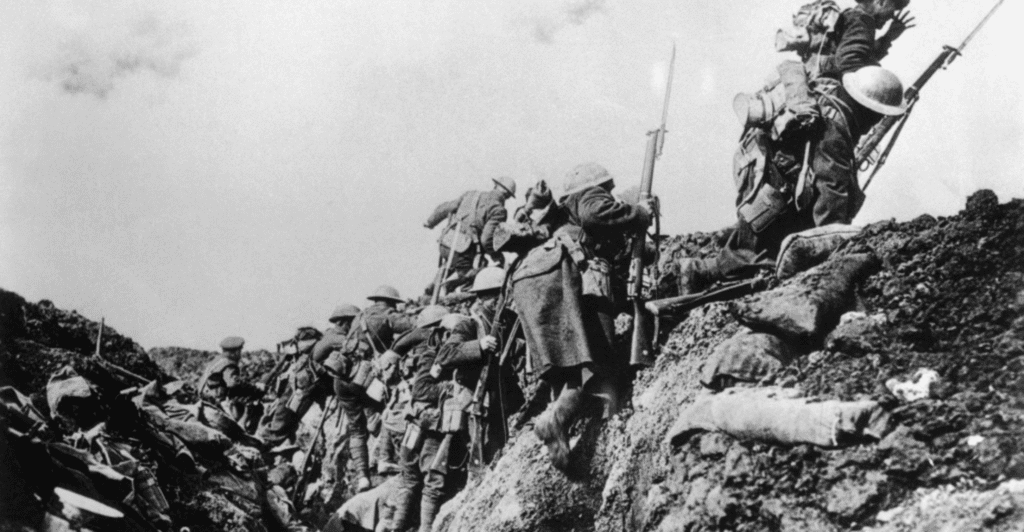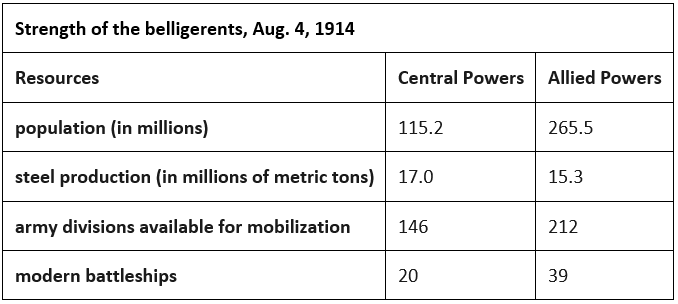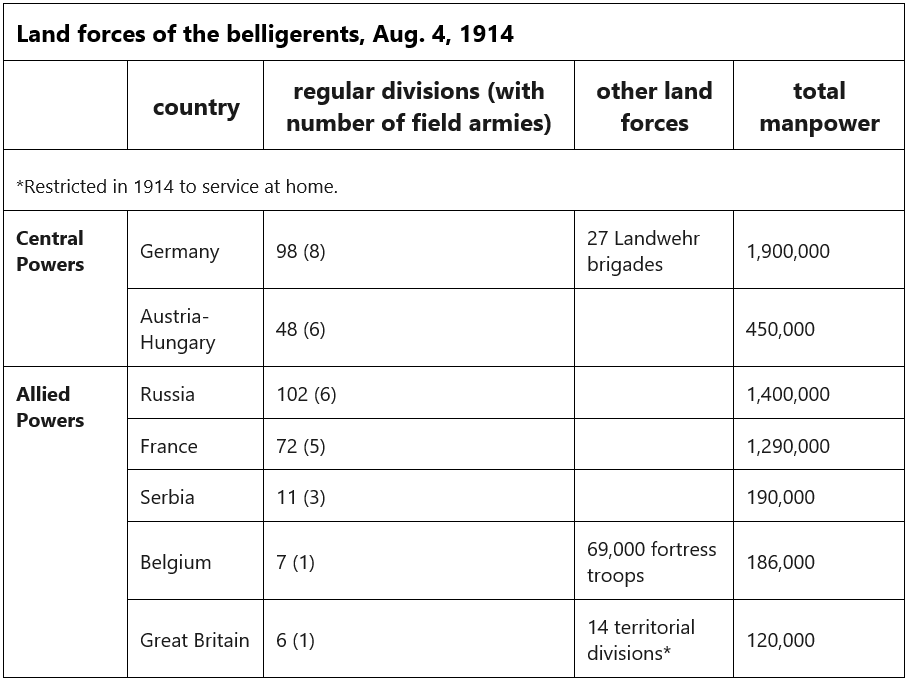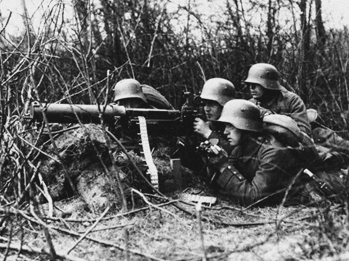Outbreak of war | UPSC Mains: World History PDF Download
What was World War I?
World War I, also called First World War or Great War, an international conflict that in 1914–18 embroiled most of the nations of Europe along with Russia, the United States, the Middle East, and other regions.
The war pitted the Central Powers mainly Germany, Austria-Hungary, and Turkey against the Allies mainly France, Great Britain, Russia, Italy, Japan, and, from 1917, the United States. It ended with the defeat of the Central Powers. The war was virtually unprecedented in the slaughter, carnage, and destruction it caused.
World War I was one of the great watersheds of 20th-century geopolitical history. It led to the fall of four great imperial dynasties (in Germany, Russia, Austria-Hungary, and Turkey), resulted in the Bolshevik Revolution in Russia, and, in its destabilization of European society, laid the groundwork for World War II.

- With Serbia already much aggrandized by the two Balkan Wars (1912–13, 1913), Serbian nationalists turned their attention back to the idea of “liberating” the South Slavs of Austria-Hungary. Colonel Dragutin Dimitrijević, head of Serbia’s military intelligence, was also, under the alias “Apis,” head of the secret society Union or Death, pledged to the pursuit of this pan-Serbian ambition.
- Believing that the Serbs’ cause would be served by the death of the Austrian archduke Franz Ferdinand, heir presumptive to the Austrian emperor Franz Joseph, and learning that the Archduke was about to visit Bosnia on a tour of military inspection, Apis plotted his assassination. Nikola Pašić, the Serbian prime minister and an enemy of Apis, heard of the plot and warned the Austrian government of it, but his message was too cautiously worded to be understood.
- At 11:15 AM on June 28, 1914, in the Bosnian capital, Sarajevo, Franz Ferdinand and his morganatic wife, Sophie, duchess of Hohenberg, were shot dead by a Bosnian Serb, Gavrilo Princip. The chief of the Austro-Hungarian general staff, Franz, Graf (count) Conrad von Hötzendorf, and the foreign minister, Leopold, Graf von Berchtold, saw the crime as the occasion for measures to humiliate Serbia and so to enhance Austria-Hungary’s prestige in the Balkans.
- Conrad had already (October 1913) been assured by William II of Germany’s support if Austria-Hungary should start a preventive war against Serbia. This assurance was confirmed in the week following the assassination, before William, on July 6, set off upon his annual cruise to the North Cape, off Norway.

Archduke Franz Ferdinand and his wife, Sophie
Austrian Archduke Franz Ferdinand and his wife, Sophie, riding in an open carriage at Sarajevo shortly before their assassination, June 28, 1914.- The Austrians decided to present an unacceptable ultimatum to Serbia and then to declare war, relying on Germany to deter Russia from intervention. Though the terms of the ultimatum were finally approved on July 19, its delivery was postponed to the evening of July 23, since by that time the French president, Raymond Poincaré, and his premier, René Viviani, who had set off on a state visit to Russia on July 15, would be on their way home and therefore unable to concert an immediate reaction with their Russian allies. When the delivery was announced, on July 24, Russia declared that Austria-Hungary must not be allowed to crush Serbia.
- Serbia replied to the ultimatum on July 25, accepting most of its demands but protesting against two of them—namely, that Serbian officials (unnamed) should be dismissed at Austria-Hungary’s behest and that Austro-Hungarian officials should take part, on Serbian soil, in proceedings against organizations hostile to Austria-Hungary. Though Serbia offered to submit the issue to international arbitration, Austria-Hungary promptly severed diplomatic relations and ordered partial mobilization.
- Home from his cruise on July 27, William learned on July 28 how Serbia had replied to the ultimatum. At once he instructed the German Foreign Office to tell Austria-Hungary that there was no longer any justification for war and that it should content itself with a temporary occupation of Belgrade. But, meanwhile, the German Foreign Office had been giving such encouragement to Berchtold that already on July 27 he had persuaded Franz Joseph to authorize war against Serbia.
- War was in fact declared on July 28, and Austro-Hungarian artillery began to bombard Belgrade the next day. Russia then ordered partial mobilization against Austria-Hungary, and on July 30, when Austria-Hungary was riposting conventionally with an order of mobilization on its Russian frontier, Russia ordered general mobilization. Germany, which since July 28 had still been hoping, in disregard of earlier warning hints from Great Britain, that Austria-Hungary’s war against Serbia could be “localized” to the Balkans, was now disillusioned insofar as eastern Europe was concerned. On July 31 Germany sent a 24-hour ultimatum requiring Russia to halt its mobilization and an 18-hour ultimatum requiring France to promise neutrality in the event of war between Russia and Germany.
- Both Russia and France predictably ignored these demands. On August 1 Germany ordered general mobilization and declared war against Russia, and France likewise ordered general mobilization. The next day Germany sent troops into Luxembourg and demanded from Belgium free passage for German troops across its neutral territory. On August 3 Germany declared war against France.
- In the night of August 3–4 German forces invaded Belgium. Thereupon, Great Britain, which had no concern with Serbia and no express obligation to fight either for Russia or for France but was expressly committed to defend Belgium, on August 4 declared war against Germany.
- Austria-Hungary declared war against Russia on August 5; Serbia against Germany on August 6; Montenegro against Austria-Hungary on August 7 and against Germany on August 12; France and Great Britain against Austria-Hungary on August 10 and on August 12, respectively; Japan against Germany on August 23; Austria-Hungary against Japan on August 25 and against Belgium on August 28.
- Romania had renewed its secret anti-Russian alliance of 1883 with the Central Powers on February 26, 1914, but now chose to remain neutral. Italy had confirmed the Triple Alliance on December 7, 1912, but could now propound formal arguments for disregarding it: first, Italy was not obliged to support its allies in a war of aggression; second, the original treaty of 1882 had stated expressly that the alliance was not against England.
- On September 5, 1914, Russia, France, and Great Britain concluded the Treaty of London, each promising not to make a separate peace with the Central Powers. Thenceforth, they could be called the Allied, or Entente, powers, or simply the Allies.
- The outbreak of war in August 1914 was generally greeted with confidence and jubilation by the peoples of Europe, among whom it inspired a wave of patriotic feeling and celebration. Few people imagined how long or how disastrous a war between the great nations of Europe could be, and most believed that their country’s side would be victorious within a matter of months. The war was welcomed either patriotically, as a defensive one imposed by national necessity, or idealistically, as one for upholding right against might, the sanctity of treaties, and international morality.
Forces and resources of the combatant nations in 1914
- When war broke out, the Allied powers possessed greater overall demographic, industrial, and military resources than the Central Powers and enjoyed easier access to the oceans for trade with neutral countries, particularly with the United States.
- Table 1 shows the population, steel production, and armed strengths of the two rival coalitions in 1914.

- All the initial belligerents in World War I were self-sufficient in food except Great Britain and Germany. Great Britain’s industrial establishment was slightly superior to Germany’s (17 percent of world trade in 1913 as compared with 12 percent for Germany), but Germany’s diversified chemical industry facilitated the production of ersatz, or substitute, materials, which compensated for the worst shortages ensuing from the British wartime blockade.
- The German chemist Fritz Haber was already developing a process for the fixation of nitrogen from air; this process made Germany self-sufficient in explosives and thus no longer dependent on imports of nitrates from Chile.
- Of all the initial belligerent nations, only Great Britain had a volunteer army, and this was quite small at the start of the war. The other nations had much larger conscript armies that required three to four years of service from able-bodied males of military age, to be followed by several years in reserve formations. Military strength on land was counted in terms of divisions composed of 12,000–20,000 officers and men. Two or more divisions made up an army corps, and two or more corps made up an army. An army could thus comprise anywhere from 50,000 to 250,000 men.
- The land forces of the belligerent nations at the outbreak of war in August 1914 are shown in Table 2.

- The higher state of discipline, training, leadership, and armament of the German army reduced the importance of the initial numerical inferiority of the armies of the Central Powers. Because of the comparative slowness of mobilization, poor higher leadership, and lower scale of armament of the Russian armies, there was an approximate balance of forces between the Central Powers and the Allies in August 1914 that prevented either side from gaining a quick victory.
- Germany and Austria also enjoyed the advantage of “interior lines of communication,” which enabled them to send their forces to critical points on the battlefronts by the shortest route. According to one estimate, Germany’s railway network made it possible to move eight divisions simultaneously from the Western Front to the Eastern Front in four and a half days.
- Even greater in importance was the advantage that Germany derived from its strong military traditions and its cadre of highly efficient and disciplined regular officers. Skilled in directing a war of movement and quick to exploit the advantages of flank attacks, German senior officers were to prove generally more capable than their Allied counterparts at directing the operations of large troop formations.
- Sea power was largely reckoned in terms of capital ships, or dreadnought battleships and battle cruisers having extremely large guns. Despite intensive competition from the Germans, the British had maintained their superiority in numbers, with the result that, in capital ships, the Allies had an almost two-to-one advantage over the Central Powers.
- The strength of the two principal rivals at sea, Great Britain and Germany, is compared in Table 3.

- The numerical superiority of the British navy, however, was offset by the technological lead of the German navy in many categories, such as range-finding equipment, magazine protection, searchlights, torpedoes, and mines. Great Britain relied on the Royal Navy not only to ensure necessary imports of food and other supplies in wartime but also to sever the Central Powers’ access to the markets of the world. With superior numbers of warships, Great Britain could impose a blockade that gradually weakened Germany by preventing imports from overseas.
Technology of war in 1914
- The planning and conduct of war in 1914 were crucially influenced by the invention of new weapons and the improvement of existing types since the Franco-German War of 1870–71. The chief developments of the intervening period had been the machine gun and the rapid-fire field artillery gun.
- The modern machine gun, which had been developed in the 1880s and ’90s, was a reliable belt-fed gun capable of sustained rates of extremely rapid fire; it could fire 600 bullets per minute with a range of more than 1,000 yards (900 metres). In the realm of field artillery, the period leading up to the war saw the introduction of improved breech-loading mechanisms and brakes.
- Without a brake or recoil mechanism, a gun lurched out of position during firing and had to be re-aimed after each round. The new improvements were epitomized in the French 75-millimetre field gun; it remained motionless during firing, and it was not necessary to readjust the aim in order to bring sustained fire on a target.
 Maxim machine gun
Maxim machine gun
German infantrymen operating a Maxim machine gun during World War I.
- Machine guns and rapid-firing artillery, when used in combination with trenches and barbed-wire emplacements, gave a decided advantage to the defense, since these weapons’ rapid and sustained firepower could decimate a frontal assault by either infantry or cavalry.
- There was a considerable disparity in 1914 between the deadly effectiveness of modern armaments and the doctrinal teachings of some armies. The South African War and the Russo-Japanese War had revealed the futility of frontal infantry or cavalry attacks on prepared positions when unaccompanied by surprise, but few military leaders foresaw that the machine gun and the rapid-firing field gun would force armies into trenches in order to survive.
- Instead, war was looked upon by many leaders in 1914 as a contest of national wills, spirit, and courage. A prime example of this attitude was the French army, which was dominated by the doctrine of the offensive. French military doctrine called for headlong bayonet charges of French infantrymen against the German rifles, machine guns, and artillery.
- German military thinking, under the influence of Alfred, Graf von Schlieffen, sought, unlike the French, to avoid frontal assaults but rather to achieve an early decision by deep flanking attacks; and at the same time to make use of reserve divisions alongside regular formations from the outset of war. The Germans paid greater attention to training their officers in defensive tactics using machine guns, barbed wire, and fortifications.
|
50 videos|69 docs|30 tests
|
FAQs on Outbreak of war - UPSC Mains: World History
| 1. What were the main causes of World War I? |  |
| 2. Which countries were involved in World War I? |  |
| 3. How did World War I impact civilians? |  |
| 4. What were the major battles of World War I? |  |
| 5. How did World War I contribute to the end of empires? |  |

















